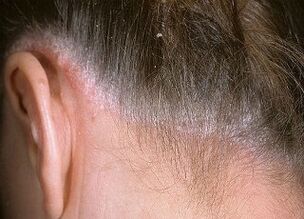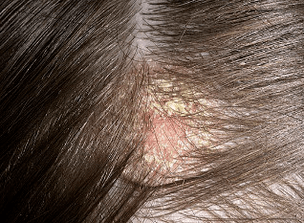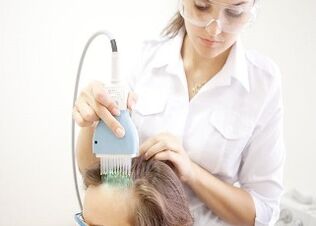
Psoriasis is a chronic disease of the upper layers of epidermal cells accompanied by dead skin flakes. The most common disease is psoriasis of the head. The disease is accompanied by the presence of large or small formations in the scalp.
Quite often the lesion is localized in one place. Late treatment can make the situation worse.
This type of disease does not spread to others. A person suffering from such a disease is safe for society.
Factors in the development of psoriasis
The main cause of skin blemishes is metabolic damage.
As already mentioned, the disease is not contagious, so the patient is not able to harm the health of those around him. The presence of psoriasis in a person indicates that the body is unable to respond normally to the presence of various stimuli. As a result, excessive cell division occurs. According to statistics, the normal process of cell division is about 30 days.
During this period, the upper layer of the epidermis gradually appears with new ones. In psoriasis, an excessive growth of new cells is observed, which begin to overlap with the old ones. The sharing period is reduced by 4 days. As a result, small scaly lesions appear on the surface of the scalp.
In most cases, they present as a mild inflammation accompanied by itching. During exfoliation of the old layer of the epidermis, pink spots of various shapes are formed on the surface of the skin. They are gradually beginning to involve them in new formations of skin cells.
Scientists have identified a number of causes that can cause a disorder in normal metabolism, including:
- Bad habits. Excessive abuse of alcohol and tobacco products causes significant changes throughout the body. In the presence of head psoriasis, the toxic substances that make up alcohol and cigarettes negatively affect the course of the disease.
- Incorrect power supply. The patient’s diet includes many products that contain large amounts of food additives and carcinogens. Bad food can be the initial stage of psoriasis.
- Mechanical damage to the hairline. In case of repeated injuries, dandruff may occur. The bacteria in the comb are able to penetrate the affected area of the scalp, thereby triggering the mechanism of the disease.
- Gastrointestinal problems.
- Unstable temperature conditions. This problem occurs during periods of seasonal changes in weather conditions.
- Long-term medication.
- Endocrine system failure.
- The body has a genetic predisposition.
If you have major signs of psoriasis on your scalp, it is recommended that you seek professional help from a dermatologist. You will choose the appropriate treatment to prevent the appearance of new lesions. Head psoriasis most often occurs between the ages of 30 and 36. It is rare in young children
Symptoms
In the early stages of psoriasis, the patient does not feel any changes. The disease progresses slowly and without discomfort. On visual inspection, the doctor rarely observes the presence of dandruff in insignificant amounts. With a more complex course of psoriasis of the scalp, the patient experiences severe itching and burning in the back of the head, forehead, and ears. Plaques with dry scaly elements form in the affected areas.
Microcracks begin to form on the skin, through which the infection enters the body. At the site of exfoliation, the dry parts of the skin begin to grow rapidly. Under mechanical stress, these plaques crack off, leaving red spots. In this case, the patient must select the appropriate medication to prevent the disease from progressing.
Main Localization Locations
Today, psoriasis of the head is a fairly common type of disease that occurs in one in four patients. Untimely treatment is the main cause of the spread of the disease throughout the body. The disease can take many forms, each of which can be accompanied by new health problems.

The main sites of scalp psoriasis are:
- skin around the ear, at the back of the head, behind the cochlea;
- frontal lobe area, parietal area;
- posterior region of cervical spine;
- separable area in hair growth.
There are two forms of the disease: mild and severe.
In the initial stage, the patient does not experience any discomfort. The main symptom may be the constant presence of dandruff, which occurs two days after washing the hair. With a severe form of the disease, the patient has psycho-emotional discomfort, a constant burning sensation and itching in the affected area of skin.
Scalp Psoriasis: Classifications and Varieties
Psoriasis of the head has several stages of the disease.
Dermatologists divide scalp psoriasis into the following sections:
- Initial.There are small pink papules that rise slightly above the skin. The patient may experience a slight itching in the affected area. By mechanical action, tiny fragments of dead epithelial cells exfoliate.
- Progressive.Here we note the presence of new changes. The patient begins to experience severe discomfort accompanied by constant itching and severe peeling. The papules gradually spread peripherally from each other.
- Fixed.At this stage, most of the scalp is affected by lesions. The old territories do not disappear, but on the contrary, they begin to move with greater force.
- Regressive.The affected area is characterized by a large number of white circles. The skin starts to dry out a lot. A large number of scaly formations are present on the surface of the papules.
A severe course of the disease can cause hair follicles to die, causing premature baldness in certain parts of the head. The exfoliating areas gradually thicken due to dead epithelial cells. Visually, light-colored growths are observed on the surface of the hair. Men are exempt from military service because moral and physical stress triggers the course of a serious illness.
Classification and varieties
There are two groups of scalp psoriasis in medicine. Each has a complex of varieties that describe all the characteristic diseases, along with the presence of similar symptoms. These include the pustular type.
Contains multiple groups:
- generalized form;
- palm plantation;
- is ring-shaped.
However, the non-pustular type is divided into
- is a traditional form of the disease;
- psoriasis.
All types and subgroups have similar symptoms but different disease progression. With the pustular type of the disease, the patient has a progressive nature of the spread of foci that require good medical treatment. In the presence of a non-pustular type, the skin is less sensitive to attack by new formations.
The course of psoriasis in childhood
In young children, psoriasis of the scalp in the initial stage is often compared to an allergic reaction - a slight redness appears on the surface of the skin with elements of exfoliation. In most cases, the affected area is compared to diaper rash, candidiasis, and eczema.
The disease is slowing down. Often, the initial impetus for the appearance of scalp defects is various medications that contain aggressive components. The child should be treated under the guidance of an experienced dermatologist.
The initial stage of therapy is a strict diet. Citrus fruits, all kinds of dyes, fatty foods, carcinogens are completely excluded from the diet. Medication is prescribed to prevent the spread of the affected areas. Mostly creams, sprays, shampoos based on medical ingredients. This therapy helps to restore the hair follicles, preventing their death.
Important
Properly selected medical measures will significantly alleviate the course of the disease.
A basic diet is chosen for each child that eliminates the rapid spread of inflamed areas. In addition to proper nutrition and drug therapy, the patient is prescribed a physiotherapy course that contributes to the rapid regeneration of the affected cells in the epidermis.
How to treat a psoriasis head in the hospital and at home
All medications for psoriasis are generally divided into two categories: external and internal. By using them, you can forget about the disease forever. As a general rule, the use of external medications is by no means always possible due to the constant growth of hair, so special balms and shampoos are replaced by various ointments.
Not everyone knows how to treat scalp psoriasis, especially when you first encounter the disease. But most internal medications are hormonal.
Various general strengthening and sedative drugs are often used in medication. These can be well-known vitamin complexes based on foil and niacin. Hospitalization of the disease is mainly performed in cases where the psoriasis is severe or moderate. Specific treatments and medications are prescribed based on the stage of the disease: standing, progressive, or regressive.
At the stage when treatment in the clinic is needed, patients no longer have time to hesitate and active measures to eliminate inflammation and disinfection begin.
In addition to the standard injection kit and a wide range of tablets, external agents such as body lotions and ointments are also used. Once the disease progresses to the next stage - the time of regression, the patient is already left for further treatment. The course of treatment usually lasts two weeks. And the doctor needs to tell you how to treat your psoriasis head at home when you are released from the hospital.
Home treatment
To date, there are no medications that can help get rid of a disease like psoriasis forever. The main purpose of home treatment is primarily to control its development.
The increase in the remission time interval is due to the use of the following resources:
- Special shampoos.
- Healing ointments.
- Infusions of various herbs.
- Baths with the addition of herbal infusions.
- UV radiation.
When prescribing home treatment, it's important to know a few rules to follow:
- All prescribed medications should be taken regularly.
- In the absence of severe symptoms, it is sufficient to use products containing aloe vera. You should only switch to any hormonal medication if the disease is severe.
- Using the prescribed creams allows you to maintain the normal moisture content of the skin.
- When prescribing sunbathing and the recently popular UV therapy procedure, it is essential to follow the schedule recommended by your doctor.
- It is advisable to use the most common means to get rid of the various manifestations of the disease. Most doctors agree that using several different ointments and medications at the same time is not desirable, as it will be impossible to determine how effective that particular treatment has been for you.
- Take a break during treatment. However, the average break time between courses varies from several weeks to six months.
- If a child develops psoriasis, they should be excluded from the disease as soon as possible. In this case, the diet is usually sufficient.
How to cure psoriasis on the scalp by folk methods

You can try to cure the disease using various folk remedies. Of course, when used alone, it is unlikely that impressive results will be achieved, as psoriasis on the head can only be cured with a complex treatment.
Folk remedies are good for alleviating the situation and also serve as additional therapies. Celandine is a plant from which funds are used for a wide variety of infectious and inflammatory skin diseases.
It has often been shown to have a positive effect on the skin in the treatment of psoriasis. Take the simplest alcoholic tincture of the plant and rub the scalp with it. It is then advisable to rinse the hair slightly with a chamomile infusion. If you experience any discomfort while using the product, you must stop using it. Although there are a huge number of masks available today, they should be used with care during treatment as they cause allergic reactions.
One of the most popular mask recipes you can make yourself is to mix the egg whites with a small spoonful of honey and apply the resulting mixture directly to your hair, rubbing it into the scalp with light massaging movements. Wash the mask after 30 minutes.
Masks based on different oils are quite effective. You can grab an essential oil such as rosemary or tea tree and add a small spoonful of almonds / coconut. The resulting mixture should be applied to the hair and kept for at least two hours. Such a mask should be washed off with a special therapeutic shampoo.
It's worth noting that you need to hesitate to foam more than once. Onion compressions are often used against the disease. They are very easy to do. Only a few oats need to be cut from the fruit and applied directly to the scalp with massaging movements. Such compaction is washed off after two hours.
For maximum effect, this procedure should be repeated at least three times a week. This drug has only one, but rather serious disadvantage, which is a strong odor that is hardly released on the same day that the compress was applied.
Therapeutic diet
Strict adherence to a specially formulated diet is one of the most important conditions for the effective treatment of psoriasis.
The point is to exclude many foods from your diet:
- Coffee.
- Different citrus fruits.
- Alcoholic beverages.
- Fruits, vegetables, but only red.
- Carbonated drinks.
- Spicy food.
- Any confectionery that contains chocolate.
- Products containing food coloring or any flavoring or preservative.
Consumption of eggs and sugar in any form should be minimized to ensure strict adherence to the diet. Once the symptoms have partially disappeared, you can reuse the foods on the blacklist in foods. However, you need to pay attention to how the body reacts. As soon as symptoms recur, the product should be eliminated from the diet.
Hair Care Rules
Brush your hair very gently and only after it is completely dry. After washing your hair, rinse with boiled water and lemon juice. And if you have a lot of plaques on your head, you can use soap every two months to wash your hair.























